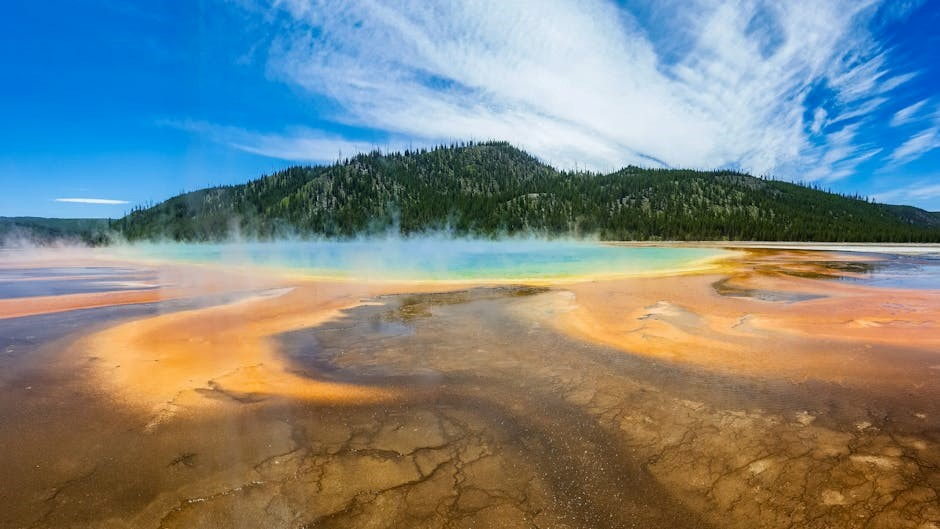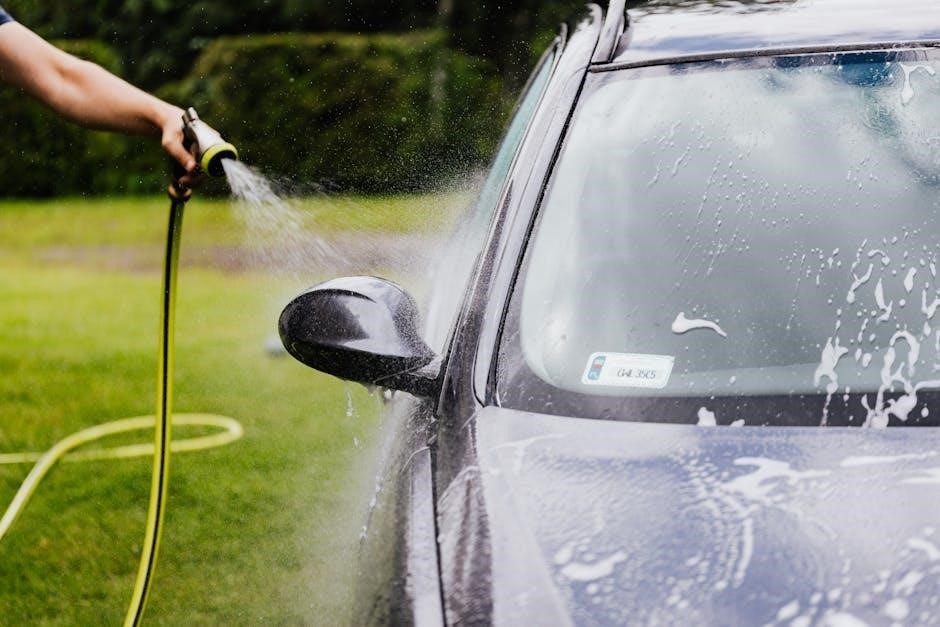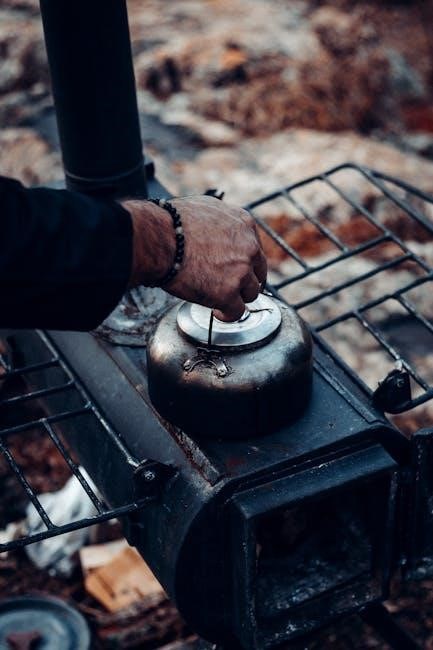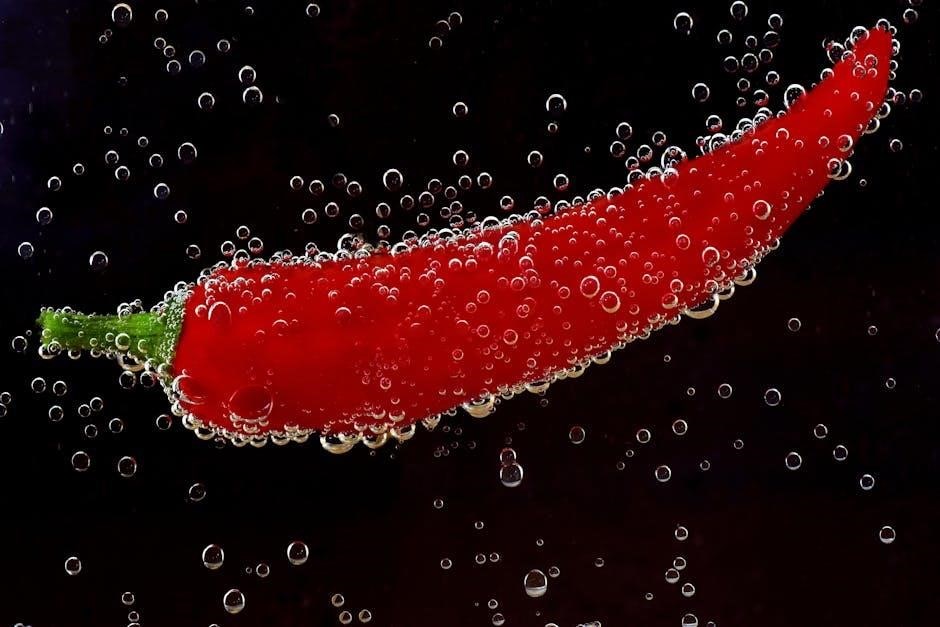
Safety Precautions
1.1 Important Safety Warnings
Always depressurize the system before maintenance. Ensure the water temperature does not exceed safe levels to avoid scalding. Use only authorized personnel for installations and repairs.
Avoid exposing the system to extreme temperatures or physical stress. Keep the area well-ventilated during operation to prevent gas accumulation. Follow all local safety regulations strictly.
Never attempt to modify the system beyond recommended guidelines. Regularly inspect for leaks or damage to maintain safe operation. Adhere to all warning labels and instructions provided.
Always depressurize the system before performing any maintenance to avoid injury from sudden pressure release. Ensure the water temperature does not exceed safe levels to prevent scalding. Never expose hot water directly to the human body during initial use‚ as it can cause severe burns. Use only authorized personnel for installations and repairs to maintain safety standards.
Avoid using rough cloths or abrasive materials to clean the system‚ as they may damage components. Keep the area well-ventilated during operation to prevent the accumulation of harmful gases. Do not modify the system beyond the manufacturer’s recommendations‚ as this can lead to unsafe conditions. Regularly inspect the system for leaks or damage to ensure safe operation. Always follow the instructions provided in the manual and adhere to all safety labels and warnings.
1.2 Precautions Before Maintenance
Before performing any maintenance on the Midea Hot Water System‚ ensure the power supply is turned off to prevent electrical shocks or injuries. Depressurize the system completely to avoid sudden releases of pressure‚ which can cause damage or harm. Rinse the system with clean water or a suitable medium as specified in the manual to remove any debris or contaminants. Clean the filters thoroughly under running water‚ ensuring no blockages remain. Avoid using harsh chemicals or abrasive materials that could damage system components. Always wear protective gear‚ including gloves and safety goggles‚ when handling system parts. Ensure the area is well-ventilated and free from flammable materials. Never smoke or use open flames near the system during maintenance. Keep the system away from children and unauthorized personnel.
1.3 Depressurizing the System
Depressurizing the system is essential before any maintenance to ensure safety and prevent potential risks. Start by turning off the power supply to the system. Next‚ close the inlet and outlet valves to isolate the system from the water supply. Open the drain valve located at the bottom of the system to allow the water to flow out. Continue draining until the pressure gauge indicates zero pressure. Once depressurized‚ double-check that no residual pressure remains in the system. This step is critical to avoid sudden releases of pressure‚ which could lead to injury or damage. Always ensure the system is depressurized before starting any maintenance or repair work.

System Components
The Midea Hot Water System includes a heat pump‚ storage tank‚ and advanced control panel. These components work together to ensure efficient and consistent hot water supply.
2.1 Overview of the Midea Hot Water System
The Midea Hot Water System is a high-efficiency appliance designed to provide continuous hot water. It combines advanced heat pump technology with a durable storage tank to optimize energy use and reduce utility bills. The system is suitable for both residential and light commercial applications‚ offering a reliable and consistent hot water supply. Its compact design makes it easy to install in various spaces‚ while the user-friendly interface ensures easy operation and monitoring. The system is built with eco-friendly materials and adheres to international energy efficiency standards‚ making it a sustainable choice for modern households.
2.2 Key Parts and Accessories
The Midea Hot Water System includes essential components such as the heat pump‚ storage tank‚ and control panel. The heat pump efficiently extracts heat from the environment‚ while the insulated storage tank ensures minimal heat loss. The control panel provides easy access to settings and monitoring. Key accessories include the three-way ball valve for water flow management‚ a faucet for hot water delivery‚ and high-quality filters to maintain water purity. Additionally‚ a tempering valve is provided to regulate water temperature safely. Other accessories may include installation kits‚ mounting brackets‚ and a remote control for convenience. These parts and accessories work together to ensure optimal performance and user satisfaction.

Installation Instructions
Ensure proper installation by authorized personnel‚ following all safety guidelines and manufacturer instructions. Connect components securely‚ test water flow‚ and verify system functionality before initial use.
3.1 Pre-Installation Checks
Before installing the Midea hot water system‚ ensure the site meets all specifications. Verify the electrical supply matches the system’s requirements and is properly grounded. Check water supply lines for leaks and adequate pressure. Ensure the area is well-ventilated and free from flammable materials. Inspect all components for damage or defects. Confirm the system’s compatibility with local water quality standards. Ensure a tempering valve is installed to regulate water temperature‚ preventing scalding. Consult local regulations for any additional requirements. Properly position the system to allow easy access for future maintenance. Ensure all necessary tools and materials are available before starting the installation process.
3.2 Step-by-Step Installation Guide
Begin by securing the Midea hot water system to a stable‚ level surface. Connect the three-way ball valve to the system‚ ensuring proper alignment with inlet and outlet pipes. Install the faucet according to the manufacturer’s instructions‚ ensuring it is compatible with the system. Connect the water supply lines‚ making sure to follow the correct hot and cold water connections. Install the tempering valve on the hot water outlet to regulate temperature safely. Connect the electrical supply‚ ensuring it matches the system’s voltage and power requirements. Turn on the water supply gradually and check for leaks at all connections. Open the hot water tap to bleed air from the system. Finally‚ test the system by running hot water through the faucet to ensure proper operation.
3.3 Installing the Three-Way Ball Valve
Mount the three-way ball valve securely to the system‚ ensuring proper alignment and stability. Connect the inlet and outlet pipes according to the valve’s directional markings. Tighten all connections firmly to prevent leaks. Open the valve slightly to allow water flow during initial system activation. Ensure the valve is accessible for future adjustments. After installation‚ turn on the water supply and inspect all connections for leaks. Proper installation ensures efficient water distribution and system performance. Follow the manufacturer’s guidelines for torque specifications to avoid over-tightening. Once installed‚ test the valve by cycling through its positions to confirm smooth operation.
3.4 Faucet Installation
Mount the faucet securely on the sink or countertop‚ ensuring it is level and stable. Connect the hot and cold water supply lines to the appropriate ports on the faucet. Tighten all connections firmly to prevent leaks. Install any additional features‚ such as a flow regulator or aerator‚ according to the manufacturer’s instructions. Once installed‚ turn on the water supply and check for any leaks around the connections. Test the faucet by running both hot and cold water to ensure proper function. Ensure the faucet is properly aligned with the sink holes for a clean finish. Follow the manual’s specific guidelines for torque and installation tools to avoid damaging the faucet or surrounding surfaces.

Operating the System
Operate the system by adjusting the user interface settings for desired water temperature and flow. Ensure all air is bled from the lines before first use. Always follow the manual’s guidelines for daily operation and shutdown procedures to maintain efficiency and safety.
4.1 First-Time Usage Guidelines
Before first-time use‚ ensure the system is properly installed and all connections are secure. Open the cold water inlet valve and allow water to flow through the system to remove any air or debris. Check for leaks at all joints and connections. Once the system is pressurized‚ turn on the hot water tap to bleed any remaining air. Adjust the temperature setting according to your preference‚ ensuring it does not exceed safe levels. Allow the system to heat the water for the recommended time before using it for the first time. Monitor the system during initial operation to ensure smooth functionality and optimal performance.
4.2 User Interface Explanation
The Midea hot water system features an intuitive user interface designed for easy operation. The control panel includes a digital display showing current temperature‚ operation mode‚ and error codes. Use the touch-sensitive buttons to adjust settings‚ such as temperature‚ timer‚ and energy-saving modes. The interface provides real-time feedback‚ ensuring you can monitor and control the system efficiently. Refer to the manual for detailed explanations of each button and display feature to optimize your usage experience. Regularly check the interface for notifications or alerts‚ which indicate maintenance needs or system status updates. This user-friendly design makes it simple to manage your hot water preferences and maintain optimal performance.
4.3 Adjusting Water Temperature
To adjust the water temperature‚ use the control panel on the Midea hot water system. Press the temperature adjustment button to cycle through available settings. The system allows you to set temperatures between 40°C and 75°C for optimal comfort and safety. Use the + or ౼ buttons to increase or decrease the temperature in 1°C increments. Always ensure the temperature is set according to your needs to avoid scalding or inefficient energy use. After setting‚ press the confirm button to save your preference. For energy efficiency‚ consider lowering the temperature during off-peak hours. Regularly check the temperature to maintain your desired level. This feature ensures precise control over your hot water supply‚ enhancing both safety and energy savings.
4.4 Daily Operation Tips
For optimal performance‚ regularly check the user interface for error codes or alerts. Ensure the system is depressurized before performing any maintenance tasks. Monitor water temperature settings to avoid excessive energy consumption or scalding risks.
Run a small amount of water through the faucet before use to ensure consistent temperature. Check for leaks around connections and valves daily. Avoid sudden temperature changes to prevent system stress.
Use the eco-mode feature during low-demand periods to save energy. Descale the system periodically if you live in areas with hard water. Keep the surrounding area clean to ensure proper airflow and efficiency.
Refer to the manual for guidance on complex adjustments. Regular inspections and timely repairs will extend the system’s lifespan. By following these tips‚ you can ensure safe‚ efficient‚ and reliable operation of your Midea hot water system.

Maintenance and Cleaning
Regular maintenance ensures optimal performance. Rinse the system with water or a suitable medium‚ and clean filters with running water to remove debris. Avoid using rough cloths.
Check for leaks and descale if necessary‚ especially in hard water areas. Dry surfaces with a soft cloth to prevent water spots and maintain hygiene.
5.1 Routine Maintenance Requirements
Regular maintenance is crucial for optimal performance. Rinse the system with water or a suitable medium to ensure cleanliness. Clean filters with running water to remove debris and ensure proper flow.
Inspect the system for leaks and descale components‚ especially in hard water areas. Dry surfaces with a soft cloth to prevent water spots and maintain hygiene. Replace worn-out parts promptly.
Check the tempering valve and ensure it’s fitted correctly by an authorized plumber. Bleed air from the system after installation or maintenance to ensure smooth operation. Follow all manufacturer guidelines strictly.
5.2 Cleaning the Filters
Regularly clean the filters to ensure efficient water flow and system performance. Use running water to rinse them thoroughly‚ ensuring no debris remains. Avoid using harsh chemicals or abrasive materials that may damage the filters.
Inspect the filter holes for blockages and clean them gently with a soft brush if necessary. After cleaning‚ allow the filters to dry completely before reinstalling. Replace filters if they are damaged or excessively worn.
Cleaning the filters helps maintain water quality and prevents contamination. Follow the manufacturer’s guidelines for specific cleaning intervals and methods to ensure optimal system functionality.
5.3 Draining and Flushing the System
Drain and flush the system periodically to remove sediment and scale buildup. Turn off the power and water supply before starting the process. Connect a hose to the drain valve and direct it to a suitable drain location.
Allow the system to drain completely. Once empty‚ flush the system with clean water to ensure all debris is removed. Repeat the process if necessary to achieve clear water flow.
Regular draining and flushing help maintain efficiency and prevent damage. Always follow the manufacturer’s instructions for specific draining procedures to ensure safety and effectiveness.

Troubleshooting Common Issues
Identify error codes and address issues like leaks‚ temperature inconsistencies‚ or system shutdowns. Refer to the manual for specific solutions or contact Midea support for assistance.
6.1 Identifying Error Codes

Refer to the error code list in the manual to diagnose issues. Codes like “E1” or “E2” indicate specific problems‚ such as temperature faults or sensor malfunctions. Ensure the system is powered off before attempting repairs. If error codes persist‚ consult the troubleshooting guide or contact Midea customer support for professional assistance. Always follow the recommended steps to avoid further damage or safety hazards. Regular maintenance can help prevent recurring issues. Keep the manual handy for quick reference when error codes appear. Addressing errors promptly ensures optimal system performance and longevity. If unsure‚ seek help from authorized personnel to resolve the issue safely and effectively.
6.2 Resolving Common Problems
For issues like no hot water‚ check the power supply and ensure the system is properly connected. If leaks occur‚ tighten all connections and inspect for damage. Strange noises may indicate loose parts or scaling—flush the system if scaling is present. Restart the system after addressing the issue to ensure proper function. If problems persist‚ refer to the troubleshooting guide or contact Midea customer support. Regular maintenance‚ such as cleaning filters and checking temperature settings‚ can prevent many common issues. Always follow the manual’s instructions for repairs to avoid further damage or safety risks. Professional assistance is recommended for complex problems to ensure optimal performance and longevity of the system.

Energy Efficiency and Cost Savings
The Midea system uses heat pump technology to reduce energy consumption and lower utility bills‚ offering an eco-friendly solution that meets high energy efficiency standards.
7.1 Benefits of the Heat Pump Technology
The Midea Heat Pump Water Heater utilizes advanced technology to extract heat from ambient air‚ providing up to three times more energy output than the electricity consumed.
This efficient system significantly reduces energy costs while maintaining consistent hot water supply. It operates quietly and is environmentally friendly‚ aligning with modern eco-conscious standards.
7.2 Tips for Reducing Energy Consumption
To minimize energy usage‚ adjust the temperature setting to a moderate level‚ ensuring it’s not excessively high. Insulate hot water pipes to reduce heat loss during distribution.
Use the timer or smart control features to activate the system only when needed‚ avoiding continuous operation. Regularly clean filters and check for leaks to maintain efficiency.
Consider upgrading to a programmable thermostat to optimize heating cycles. By following these tips‚ you can significantly lower energy consumption while enjoying consistent hot water supply.

Technical Specifications
The Midea Hot Water System features a 170-liter capacity‚ utilizing advanced heat pump technology. It meets NEEA Tier 4 and CEE Advanced Tier specifications‚ ensuring high efficiency and reliability.
8.1 Compliance with Standards
The Midea Hot Water System is designed to meet rigorous international standards‚ ensuring safety‚ efficiency‚ and environmental compliance. It adheres to NEEA Tier 4 and CEE Advanced Tier specifications‚ guaranteeing high performance and energy savings. The system is certified to ISO 9001:2015 standards for quality management and ISO 14001:2015 for environmental management. It also complies with local and national safety regulations‚ including electrical and water quality standards. The heat pump technology is designed to minimize environmental impact‚ meeting global eco-friendly requirements. This compliance ensures the system operates reliably while reducing energy consumption and carbon emissions‚ aligning with both current and future environmental goals.
8.2 Performance and Capacity Details
The Midea Hot Water System offers exceptional performance with a capacity of 170 liters‚ ideal for medium to large households. It features an energy efficiency ratio (EER) of 3:1‚ delivering three units of heat energy for every unit of electricity consumed. The system operates efficiently across a wide temperature range‚ from 40°C to 75°C‚ ensuring consistent hot water supply. Equipped with advanced heat pump technology‚ it minimizes energy loss and maximizes water heating efficiency. The system also includes smart controls for precise temperature adjustment and energy monitoring. Designed for durability‚ it operates quietly and reliably‚ making it suitable for both residential and light commercial use. This combination of capacity‚ efficiency‚ and innovative features ensures optimal performance and long-term savings.

Warranty and Support
Midea offers a comprehensive warranty covering parts and labor for up to 6 years. Contact customer support via phone or email for assistance with installations‚ repairs‚ or inquiries;
9.1 Warranty Terms and Conditions
Midea’s warranty covers the hot water system for up to 6 years‚ including parts and labor‚ subject to proper installation and maintenance. Registration is required within 30 days of purchase to activate the warranty. The warranty does not cover damage caused by misuse‚ improper installation‚ or unauthorized modifications. Repairs must be performed by authorized Midea technicians. For warranty claims‚ contact Midea customer support with proof of purchase and installation. The warranty is void if the system is operated outside recommended specifications or exposed to extreme conditions. Regular maintenance‚ as outlined in the manual‚ is essential to maintain warranty validity. Keep the proof of purchase and installation records for verification purposes.
9.2 Contacting Midea Customer Support
To contact Midea customer support‚ visit their official website for regional contact details. Phone‚ email‚ and live chat options are available for assistance. Ensure you have your model number and purchase details ready for efficient service. For technical issues or warranty claims‚ provide a clear description of the problem. Support is available Monday to Friday‚ 9 AM to 6 PM‚ excluding holidays. You can also submit a service request through the online portal. Midea’s dedicated team aims to resolve inquiries promptly‚ ensuring minimal downtime and optimal system performance. Always verify the authenticity of support channels to avoid unauthorized services.
The Midea Hot Water System offers efficient‚ safe‚ and reliable performance. Follow guidelines for optimal use‚ maintenance‚ and troubleshooting to ensure long-lasting functionality and energy savings.
10.1 Summary of Key Points
The Midea Hot Water System manual emphasizes safety‚ efficiency‚ and proper installation. Key points include adhering to safety precautions‚ following installation guidelines‚ and regular maintenance to ensure optimal performance. The system utilizes advanced heat pump technology to reduce energy consumption and lower utility bills. Proper usage and troubleshooting techniques are outlined to address common issues. Users are encouraged to refer to the manual for detailed instructions on operation‚ maintenance‚ and troubleshooting. By following the guidelines‚ users can enjoy reliable hot water supply while minimizing energy costs. The manual also highlights the importance of professional assistance for complex tasks‚ ensuring longevity and safety of the system.
10.2 Final Tips for Optimal Performance
To maximize the efficiency and longevity of your Midea Hot Water System‚ ensure regular maintenance routines are followed. Clean filters periodically to prevent clogging and maintain water flow. Check and adjust temperature settings to avoid excessive energy consumption while ensuring water is sufficiently heated. Inspect pipes and connections for leaks to prevent water loss and damage. Additionally‚ consider optimizing water usage habits to reduce overall demand. By following these guidelines‚ you can enjoy consistent hot water supply while minimizing energy costs and extending the system’s lifespan. Regular servicing by professionals is also recommended to address any underlying issues before they escalate.